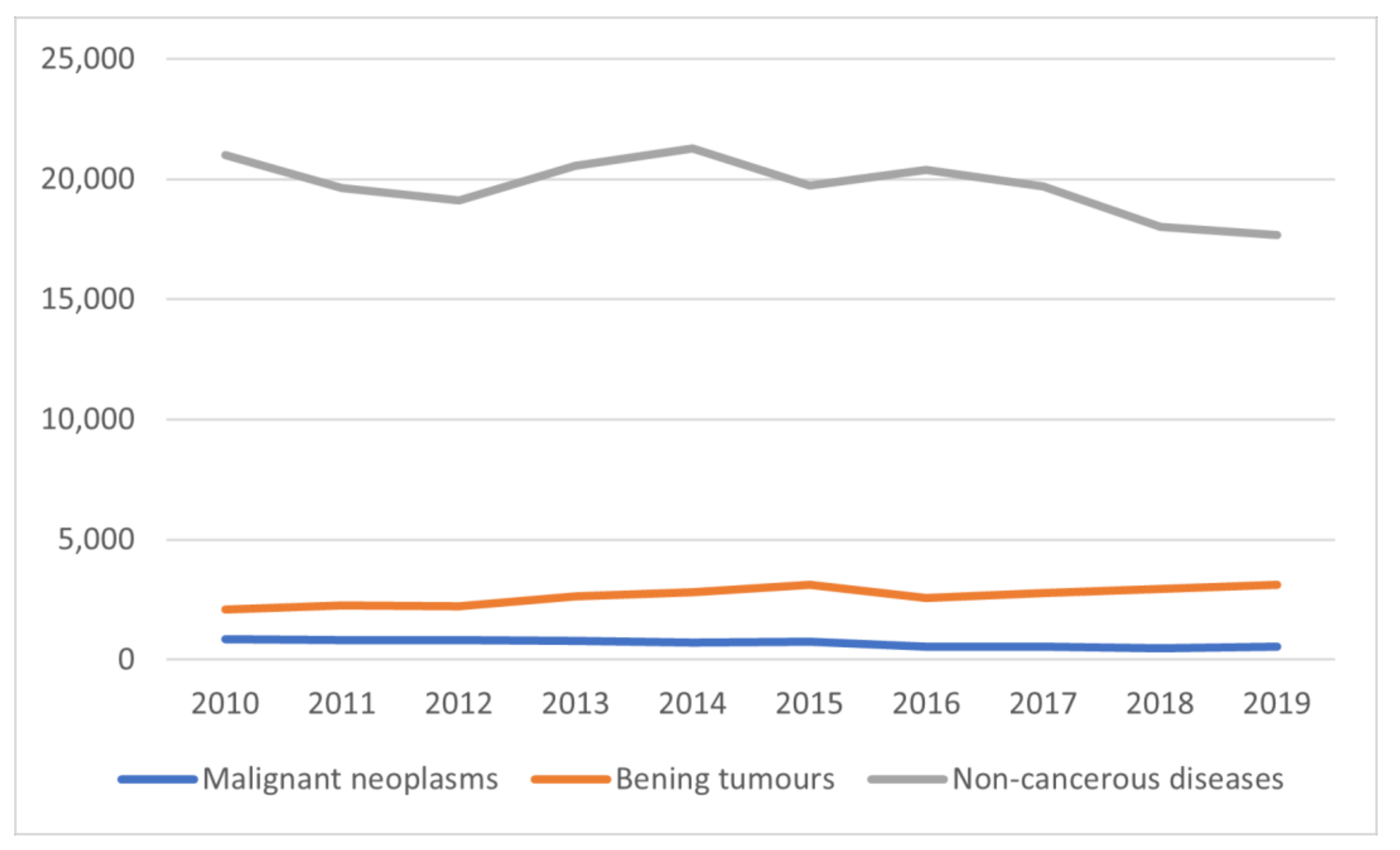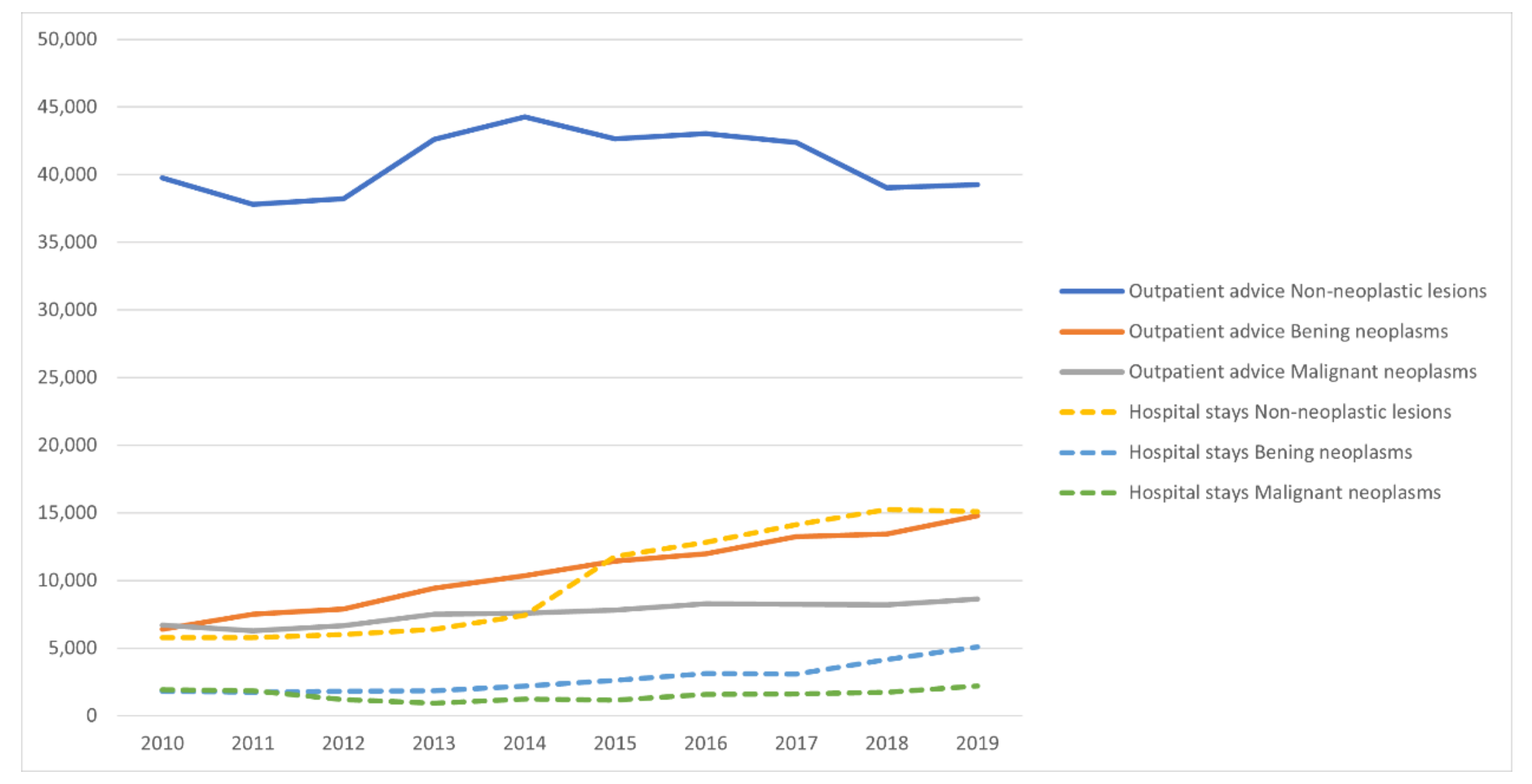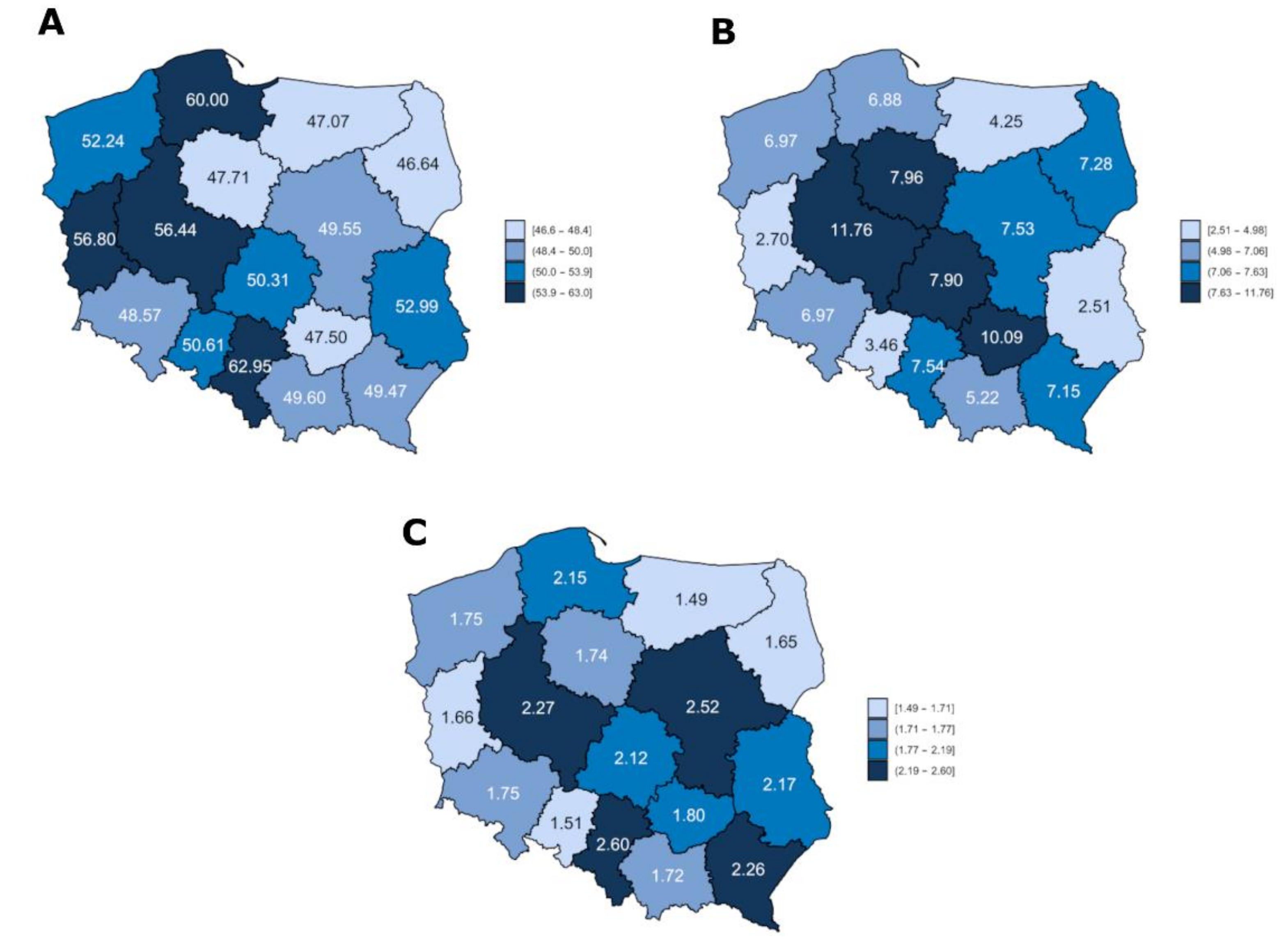The Epidemiology of Salivary Glands Pathologies in Adult Population over 10 Years in Poland—Cohort Study
Abstract
:1. Introduction
2. Materials and Methods
- Malignant neoplasms: C07, C08, C08.0, C08.1, C08.8, C08.9
- Benign neoplasms: D11, D11.0, D11.7, D11.9
- Non-neoplastic diseases: K11.0, K11.1, K11.2, K11.3, K11.4, K11.5, K11.6, K11.7, K11.8, K11.9
3. Results
3.1. Incidence Rates and Characteristics of Patients
3.2. Outpatient and Inpatient Care
3.3. Regional Prevalence
4. Discussion
5. Conclusions
Supplementary Materials
Author Contributions
Funding
Institutional Review Board Statement
Informed Consent Statement
Data Availability Statement
Conflicts of Interest
References
- Carlson, E.R.; Schlieve, T. Salivary Gland Malignancies. Oral Maxillofac Surg. Clin. N. Am. 2019, 31, 125–144. [Google Scholar] [CrossRef] [PubMed]
- Wang, X.D.; Meng, L.J.; Hou, T.T.; Huang, S.H. Tumours of the salivary glands in northeastern China: A retrospective study of 2508 patients. Br. J. Oral Maxillofac Surg. 2015, 53, 132–137. [Google Scholar] [CrossRef]
- Stryjewska-Makuch, G.; Kolebacz, B.; Janik, M.A.; Wolnik, A. Increase in the incidence of parotid gland tumors in the years 2005–2014. Otolaryngol. Pol. 2017, 71, 29–34. [Google Scholar] [CrossRef] [Green Version]
- Kordzinska-Cisek, I.; Grzybowska-Szatkowska, L. Salivary gland cancer—Epidemiology. Nowotw. J. Oncol. 2018, 68, 22–27. [Google Scholar] [CrossRef] [Green Version]
- Gatta, G.; Guzzo, M.; Locati, L.D.; McGurk, M.; Prott, F.J. Major and minor salivary gland tumours. Crit. Rev. Oncol. Hematol. 2020, 152, 102959. [Google Scholar] [CrossRef]
- Pfister, D.G.; Spencer, S.; Adelstein, D.; Adkins, D.; Anzai, Y.; Brizel, D.M.; Bruce, J.Y.; Busse, P.M.; Caudell, J.J.; Cmelak, A.J.; et al. Head and Neck Cancers, Version 2.2020, NCCN Clinical Practice Guidelines in Oncology. J. Natl. Compr. Canc. Netw. 2020, 18, 873–898. [Google Scholar] [CrossRef]
- Bradley, P.J.; McGurk, M. Incidence of salivary gland neoplasms in a defined UK population. Br. J. Oral Maxillofac Surg. 2013, 51, 399–403. [Google Scholar] [CrossRef] [PubMed]
- Cascarini, L.; McGurk, M. Epidemiology of salivary gland infections. Oral Maxillofac Surg. Clin. N. Am. 2009, 21, 353–357. [Google Scholar] [CrossRef]
- Wilson, K.F.; Meier, J.D.; Ward, P.D. Salivary gland disorders. Am. Fam. Physician 2014, 89, 882–888. [Google Scholar] [PubMed]
- The National Health Fund Data. Available online: https://www.nfz.gov.pl/ (accessed on 30 June 2021).
- Statistics Poland. Available online: https://stat.gov.pl/ (accessed on 30 June 2021).
- Ziolkowska, M.; Bien, S.; Okla, S.; Zylka, S. Epidemiological and clinical characteristics of 705 salivary glands neoplasms. Otolaryngol. Pol. 2013, 67, 154–163. [Google Scholar]
- Kubacka, M.; Orendorz-Fraczkowska, K.; Pazdro-Zastawny, K.; Morawska-Kochman, M.; Krecicki, T. Epidemiological evaluation of salivary gland tumors in the Wroclaw ENT Department patients in the years 2001–2010. Otolaryngol. Pol. 2013, 67, 30–33. [Google Scholar] [CrossRef] [PubMed]
- Israel, Y.; Rachmiel, A.; Ziv, G.; Nagler, R. Benign and Malignant Salivary Gland Tumors—Clinical and Demographic Characteristics. Anticancer Res. 2016, 36, 4151–4154. [Google Scholar]
- Erovic, B.M.; Shah, M.D.; Bruch, G.; Johnston, M.; Kim, J.; O’Sullivan, B.; Perez-Ordonez, B.; Weinreb, I.; Atenafu, E.G.; de Almeida, J.R.; et al. Outcome analysis of 215 patients with parotid gland tumors: A retrospective cohort analysis. J. Otolaryngol.-Head Neck Surg. 2015, 44, 43. [Google Scholar] [CrossRef] [PubMed] [Green Version]
- Bjorndal, K.; Krogdahl, A.; Therkildsen, M.H.; Overgaard, J.; Johansen, J.; Kristensen, C.A.; Homoe, P.; Sorensen, C.H.; Andersen, E.; Bundgaard, T.; et al. Salivary gland carcinoma in Denmark 1990–2005: A national study of incidence, site and histology. Results of the Danish Head and Neck Cancer Group (DAHANCA). Oral Oncol. 2011, 47, 677–682. [Google Scholar] [CrossRef] [PubMed]
- Luukkaa, H.; Klemi, P.; Leivo, I.; Koivunen, P.; Laranne, J.; Makitie, A.; Virtaniemi, J.; Hinkka, S.; Grenman, R. Salivary gland cancer in Finland 1991–96: An evaluation of 237 cases. Acta Otolaryngol. 2005, 125, 207–214. [Google Scholar] [CrossRef] [PubMed]
- Tian, Z.; Li, L.; Wang, L.; Hu, Y.; Li, J. Salivary gland neoplasms in oral and maxillofacial regions: A 23-year retrospective study of 6982 cases in an eastern Chinese population. Int. J. Oral Maxillofac Surg. 2010, 39, 235–242. [Google Scholar] [CrossRef] [PubMed]
- Westergaard-Nielsen, M.; Godballe, C.; Eriksen, J.G.; Larsen, S.R.; Kiss, K.; Agander, T.; Ulhoi, B.P.; Charabi, B.; Klug, T.E.; Jacobsen, H.; et al. Salivary gland carcinoma in Denmark: A national update and follow-up on incidence, histology, and outcome. Eur. Arch. Otorhinolaryngol. 2021, 278, 1179–1188. [Google Scholar] [CrossRef] [PubMed]
- Van Dijk, B.A.; Gatta, G.; Capocaccia, R.; Pierannunzio, D.; Strojan, P.; Licitra, L.; Group, R.W. Rare cancers of the head and neck area in Europe. Eur. J. Cancer 2012, 48, 783–796. [Google Scholar] [CrossRef]
- Guzzo, M.; Locati, L.D.; Prott, F.J.; Gatta, G.; McGurk, M.; Licitra, L. Major and minor salivary gland tumors. Crit. Rev. Oncol. Hematol. 2010, 74, 134–148. [Google Scholar] [CrossRef]
- Del Signore, A.G.; Megwalu, U.C. The rising incidence of major salivary gland cancer in the United States. Ear Nose Throat J. 2017, 96, E13–E16. [Google Scholar] [CrossRef]
- Kopec, T.; Wierzbicka, M.; Szyfter, W.; Bem, G. Incidence of salivary gland malignancies in 12 year time period in ENT Department Medical University in Poznan. Otolaryngol. Pol. 2010, 64, 288–295. [Google Scholar] [PubMed]
- Ostman, J.; Anneroth, G.; Gustafsson, H.; Tavelin, B. Malignant salivary gland tumours in Sweden 1960–1989—An epidemiological study. Oral Oncol. 1997, 33, 169–176. [Google Scholar] [CrossRef]



| ICD-10 Code | Description | Group of Pathologies |
|---|---|---|
| C07 | Malignant neoplasm of parotid gland | Malignant neoplasms |
| C08 | Malignant neoplasm of other and unspecified major salivary glands | |
| C08.0 | Submandibular gland | |
| C08.1 | Sublingual gland | |
| C08.8 | Overlapping lesion of major salivary glands | |
| C08.9 | Major salivary gland, unspecified | |
| D11 | Benign neoplasm of major salivary glands | Benign neoplasms |
| D11.0 | Parotid gland | |
| D11.7 | Other major salivary glands | |
| D11.9 | Major salivary gland, unspecified | |
| K11 | Diseases of salivary glands | Non-neoplastic |
| K11.0 | Atrophy of salivary gland | |
| K11.1 | Hypertrophy of salivary gland | |
| K11.2 | Sialadenitis | |
| K11.3 | Abscess of salivary gland | |
| K11.4 | Fistula of salivary gland | |
| K11.5 | Sialolithiasis | |
| K11.6 | Mucocele of salivary gland | |
| K11.7 | Disturbances of salivary secretion | |
| K11.8 | Other diseases of the salivary glands | |
| K11.9 | Disease of salivary gland, unspecified |
| Salivary Gland Pathologies | 2010 | 2011 | 2012 | 2013 | 2014 | 2015 | 2016 | 2017 | 2018 | 2019 | Total | Percentage of Incidence | |
|---|---|---|---|---|---|---|---|---|---|---|---|---|---|
| Number of new cases according to type of pathology | |||||||||||||
| Non-neoplastic lesions | 21,004 | 19,632 | 19,128 | 20,559 | 21,280 | 19,718 | 20,399 | 19,714 | 18,019 | 17,691 | 197,144 | 85.50% | |
| Benign neoplasms | 2080 | 2273 | 2244 | 2634 | 2812 | 3110 | 2579 | 2791 | 2955 | 3123 | 26,601 | 11.53% | |
| Malignant neoplasms | 847 | 807 | 812 | 778 | 732 | 737 | 557 | 533 | 485 | 556 | 6844 | 2.97% | |
| Incidence per 100,000 adult inhabitants | |||||||||||||
| Non-neoplastic lesions | 54.514 | 50.941 | 49.64 | 53.406 | 55.303 | 51.299 | 53.077 | 51.294 | 46.911 | 46.091 | 51.25 | ||
| Benign neoplasms | 5.398 | 5.898 | 5.824 | 6.842 | 7.308 | 8.091 | 6.71 | 7.262 | 7.693 | 8.137 | 6.915 | ||
| Malignant neoplasms | 2.198 | 2.094 | 2.107 | 2.021 | 1.902 | 1.917 | 1.449 | 1.387 | 1.263 | 1.449 | 1.779 | ||
| All pathologies of the salivary glands | 62.11 | 58.933 | 57.571 | 62.269 | 64.514 | 61.308 | 61.236 | 59.942 | 55.867 | 55.676 | 59.944 | ||
| Age of patients according to the type of pathology (mean age ± SD) | |||||||||||||
| Non-neoplastic lesions | 48.19 ± 20.48 | 49 ± 24.74 | 49.11 ± 20.54 | 49.89 ± 20.29 | 50.22 ± 20.47 | 50.21 ± 20.71 | 50.92 ± 20.67 | 51.19 ± 20.57 | 51.59 ± 20.98 | 51.93 ± 21.09 | 50.23 ± 21.05 | ||
| Benign neoplasms | 52.77 ± 17.09 | 54.09 ± 17.42 | 54.1 ± 17.5 | 54.61 ± 17.19 | 54.81 ± 17.51 | 55.91 ± 17.01 | 56.32 ± 17.26 | 55.98 ± 16.85 | 57.25 ± 16.84 | 56.86 ± 16.81 | 55.27 ± 17.15 | ||
| Malignant neoplasms | 61.04 ± 16.39 | 61.23 ± 15.92 | 60.42 ± 15.97 | 60.15 ± 16.95 | 63.38 ± 16.91 | 63.06 ± 15.77 | 63.07 ± 15.8 | 62.28 ± 16.96 | 64.5 ± 14.97 | 62.84 ± 16.97 | 62.2 ± 16.26 | ||
| Gender structure of patients according to type of pathology | |||||||||||||
| Non-neoplastic lesions | Men (%) | 38.73% | 38.98% | 38.31% | 38.80% | 38.53% | 38.50% | 38.93% | 39.53% | 38.73% | 38.92% | 38.80% | |
| Women (%) | 61.27% | 61.02% | 61.69% | 61.20% | 61.47% | 61.50% | 61.07% | 60.47% | 61.27% | 61.08% | 61.20% | ||
| Benign neoplasms | Men (%) | 43.32% | 44.21% | 44.83% | 45.52% | 43.81% | 45.98% | 45.72% | 45.90% | 44.20% | 46.30% | 44.98% | |
| Women (%) | 56.68% | 55.79% | 55.17% | 54.48% | 56.19% | 54.02% | 54.28% | 54.10% | 55.80% | 53.70% | 55.02% | ||
| Malignant neoplasms | Men (%) | 58.44% | 55.27% | 54.93% | 60.93% | 53.69% | 54.55% | 55.30% | 54.60% | 59.38% | 59.89% | 56.70% | |
| Women (%) | 41.56% | 44.73% | 45.07% | 39.07% | 46.31% | 45.45% | 44.70% | 45.40% | 40.62% | 40.11% | 43.30% | ||
| Salivary Gland Pathologies | 2010 | 2011 | 2012 | 2013 | 2014 | 2015 | 2016 | 2017 | 2018 | 2019 | Total | Average Number of Services per Patient (± SD) |
|---|---|---|---|---|---|---|---|---|---|---|---|---|
| Number of outpatient consultations | ||||||||||||
| Non-neoplastic lesions | 39,765 | 37,808 | 38,217 | 42,616 | 44,267 | 42,634 | 43,050 | 42,366 | 39,023 | 39,249 | 408,995 | 2.07 ± 0.11 |
| Benign neoplasms | 6411 | 7506 | 7880 | 9445 | 10,361 | 11,426 | 11,951 | 13,237 | 13,435 | 14,803 | 106,455 | 4 ± 0.64 |
| Malignant neoplasms | 6684 | 6280 | 6666 | 7491 | 7599 | 7823 | 8271 | 8253 | 8212 | 8612 | 75,891 | 11.09 ± 3.58 |
| Number of hospital stays | ||||||||||||
| Non-neoplastic lesions | 5786 | 5781 | 6012 | 6390 | 7437 | 11,786 | 12,807 | 14,121 | 15,253 | 15,073 | 100,446 | 0.51 ± 0.24 |
| Benign neoplasms | 1800 | 1734 | 1808 | 1844 | 2180 | 2612 | 3104 | 3080 | 4153 | 5076 | 27,391 | 1.03 ± 0.31 |
| Malignant neoplasms | 1933 | 1836 | 1197 | 911 | 1233 | 1162 | 1589 | 1596 | 1721 | 2191 | 15,369 | 2.25 ± 0.93 |
Publisher’s Note: MDPI stays neutral with regard to jurisdictional claims in published maps and institutional affiliations. |
© 2021 by the authors. Licensee MDPI, Basel, Switzerland. This article is an open access article distributed under the terms and conditions of the Creative Commons Attribution (CC BY) license (https://creativecommons.org/licenses/by/4.0/).
Share and Cite
Żurek, M.; Rzepakowska, A.; Jasak, K.; Niemczyk, K. The Epidemiology of Salivary Glands Pathologies in Adult Population over 10 Years in Poland—Cohort Study. Int. J. Environ. Res. Public Health 2022, 19, 179. https://doi.org/10.3390/ijerph19010179
Żurek M, Rzepakowska A, Jasak K, Niemczyk K. The Epidemiology of Salivary Glands Pathologies in Adult Population over 10 Years in Poland—Cohort Study. International Journal of Environmental Research and Public Health. 2022; 19(1):179. https://doi.org/10.3390/ijerph19010179
Chicago/Turabian StyleŻurek, Michał, Anna Rzepakowska, Kamil Jasak, and Kazimierz Niemczyk. 2022. "The Epidemiology of Salivary Glands Pathologies in Adult Population over 10 Years in Poland—Cohort Study" International Journal of Environmental Research and Public Health 19, no. 1: 179. https://doi.org/10.3390/ijerph19010179
APA StyleŻurek, M., Rzepakowska, A., Jasak, K., & Niemczyk, K. (2022). The Epidemiology of Salivary Glands Pathologies in Adult Population over 10 Years in Poland—Cohort Study. International Journal of Environmental Research and Public Health, 19(1), 179. https://doi.org/10.3390/ijerph19010179






